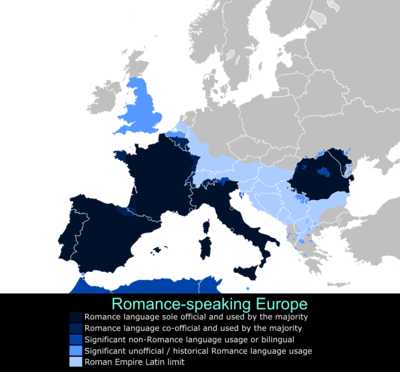lingvo.wikisort.org - Language
Moselle Romance (German: Moselromanisch; French: Roman de la Moselle) is an extinct Gallo-Romance (most probably Langue d'oïl) dialect that developed after the fall of the Roman Empire along the Moselle river in modern-day Germany, near the border with France. It was part of a wider group of Romance relic areas within the German-speaking territory.[2] Despite heavy Germanic influence, it persisted in isolated pockets until the 11th century.[3]
| Moselle Romance | |
|---|---|
| Native to | Germany |
| Region | Along the Moselle River near France |
| Extinct | 11th century |
Language family | |
Early forms | Old Latin
|
| Language codes | |
| ISO 639-3 | – |

Historical background

After Julius Caesar conquered Gaul in 50 BC, a Gallo-Roman culture gradually developed in what is today France, southern Belgium, Luxembourg, and the region between Trier and Koblenz. By contrast, the adjacent province of Germania Inferior and part of Germania Superior retained a Germanic character throughout the Imperial period.
Emergence
The Angles and Saxons, en route to England from their ancestral lands in the western Netherlands and Germany, carved a path through Holland, Flanders, and Brabant and sent the local Franks fleeing southeast along the Ourthe and Sauer rivers to the region around Metz and the Upper Moselle. This drove a sixty-kilometer wedge between the Gallo-Romans in the Trier-Koblenz area and their linguistic brethren in the rest of Gaul.[citation needed]
Judging by the archeological evidence, these newly arrived Franks practiced farming and animal husbandry about Bitburg, Gutland, the Middle and Upper Saar, and the Moselle Valley – strongly preferring these last two over the others.[citation needed]
According to linguist Alberto Varvaro the linguistic frontier between German and Latin populations around the 13th century was similar to the present language frontier, but only a few years before there still was a "remaining area of neolatin speakers" in the valleys of the Mosella river (near old Roman Treviri).[4]
Decline
The local Gallo-Roman placenames suggest that the left bank of the Moselle was Germanized following the 8th century, but the right bank remained Romance-speaking into at least the 10th century. Said names include Maring-Noviand, Osann-Monzel, Longuich, Riol, Hatzenport, Longkamp, Karden, and Kröv or Alf. This being a wine-growing region, a number of viticultural terms from Moselle Romance have survived in the local German dialect.[3]
Features
The following Late Latin inscription from the sixth century is assumed to show influence from early Moselle Romance:
- Hoc tetolo fecet Montana, coniux sua, Mauricio, qui visit con elo annus dodece; et portavit annus qarranta; trasit die VIII K(a)l(endas) Iunias.
"For Mauricius his wife Montana who lived with him for twelve years made this gravestone; he was forty years old and died on the 25th of May."[5]
A Latin text from the 9th century written in the monastery of Prüm by local monks contains several Vulgar Latin terms which are attested only in modern Gallo-Romance languages, especially northeastern French and Franco-Provençal, such materiamen 'timber' or porritum 'chives'. Based on evidence from toponyms and loanwords into Moselle Franconian dialects, the latest detectable form of Moselle Romance can be classified as a Langue d'oïl dialect. This can seen e.g. in the placenames Kasnode < *cassanētu and Roveroth < *roburētu, which display a characteristic change of Vulgar Latin stressed /e/ in open syllables.[6]
See also
References
- Hammarström, Harald; Forkel, Robert; Haspelmath, Martin; Bank, Sebastian (24 May 2022). "Oil". Glottolog. Max Planck Institute for Evolutionary Anthropology. Archived from the original on 8 October 2022. Retrieved 7 October 2022.
- Haubrichs, Wolfgang (2003). "Die verlorene Romanität im deutschen Sprachraum". In Gerhard Ernst; Martin-Dietrich Gleßgen; Christian Schmitt; Wolfgang Schweickard (eds.). Romanische Sprachgeschichte. Berlin: Walter de Gruyter. pp. 695–709. ISBN 9783110194128.
- Post, Rudolf (2004). "Zur Geschichte und Erforschung des Moselromanischen". Rheinische Vierteljahrsblätter. 68: 1–35. ISSN 0035-4473.
- Alberto Varvaro."Federiciana". Treccani Enciclopedia ()
- Johannes Kramer: Zwischen Latein und Moselromanisch. Die Gondorfer Grabinschrift für Mauricius. In: Zeitschrift für Papyrologie und Epigraphik, Bd. 118 (1997) S. 281–286, ISSN 0084-5388 (PDF; 292 kB)
- Pitz, Martina (2008). "Zu Genese und Lebensdauer der romanischen Sprachinseln an Mosel und Mittelrhein". In Greule, Albrecht (ed.). Studien zu Literatur, Sprache und Geschichte in Europa: Wolfgang Haubrichs zum 65. Geburtstag gewidmet. St. Ingbert: Röhrig Universitätsverlag. pp. 439–450. ISBN 9783861104360.
- Wolfgang Jungandreas: Zur Geschichte des Moselromanischen. Studien zur Lautchronologie und zur Winzerlexik (Mainzer Studien zur Sprach- und Volksforschung; 3). Steiner Verlag, Wiesbaden 1979, ISBN 3-515-03137-5.
На других языках
- [en] Moselle Romance
[es] Lengua romance del Mosela
La lengua romance del Mosela fue una lengua romance que existió en el valle del Mosela (en la actual Alemania) desde la caída del Imperio romano hasta el siglo XIII.[it] Lingua romanza della Mosella
La Lingua romanza della Mosella era un idioma romanzo, ascrivibile al gruppo delle lingue gallo-romanze, esistita nella regione della Mosella, storicamente parte della provincia romana della Gallia Belgica (oggi compresa tra la regione francese del Grande Est, il land tedesco della Renania-Palatinato ed il distretto lussemburghese di Grevenmacher), dalla caduta dell'Impero romano d'Occidente fino al Duecento.Другой контент может иметь иную лицензию. Перед использованием материалов сайта WikiSort.org внимательно изучите правила лицензирования конкретных элементов наполнения сайта.
WikiSort.org - проект по пересортировке и дополнению контента Википедии